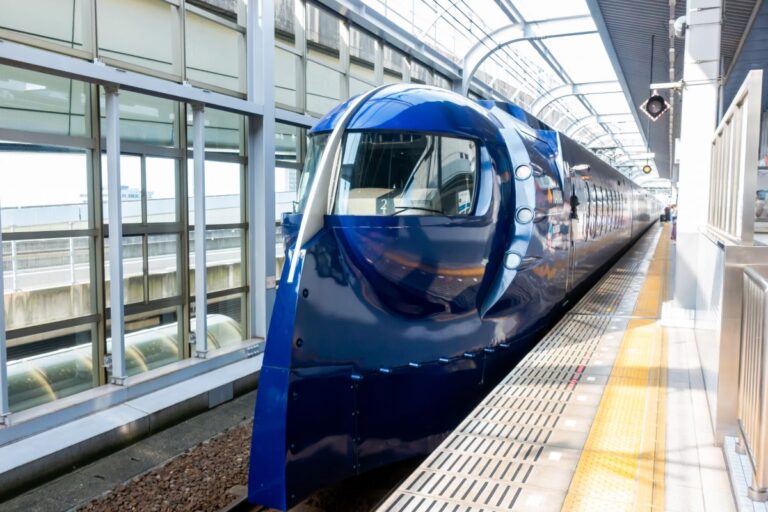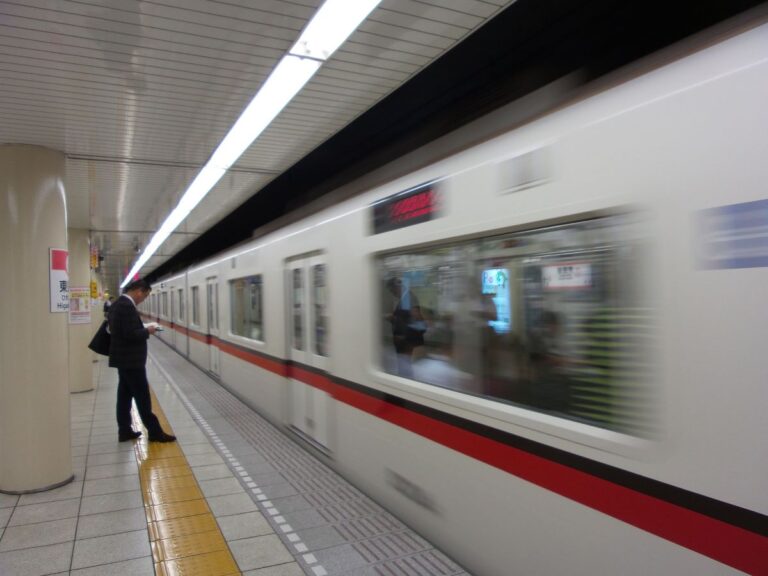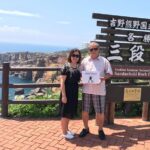The quaint Enoshima Dentetsu line (“Enoden” for short) is a popular excursion out of Tokyo, giving access to the beaches and resorts around Enoshima Island, as well as some lovely views of the ocean and mountains. Ever since the private railway began operations 1902, the little two-car electric trolleys have been clanking along a route from the city of Kamakura, through the mountains ringing the city, and along the shore to the city of Fujisawa. Along the way, it passes some of Japan’s most important historic sites.
The city of Kamakura, an hour south of Tokyo on the Tokaido Line, was the seat of the Kamakura Shogunate, a sort of mini-Kyoto, from 1185 to 1333. The first shogun, Morimoto Yoshitomo, chose it as his base because of its natural defenses — protected on three sides by rugged hills, and on the fourth by the ocean.
Kamakura was the birthplace of both Zen and Nichiren Buddhism, and as a result the city and its surroundings are packed with beautiful and historically significant temples, treasures and tales of intrigue. Nowadays it is a pretty little burg with trendy shops and restaurants, and in addition to being a popular tourist destination, it is a desirable place to live for well-to-do people who want a quiet lifestyle within commuting distance of Tokyo. It should be near the top of any visitor’s itinerary.
At Hase, two stops along the Enoden route and a few minutes’ walk from the station, is the Dai Butsu (Big Buddha), one of the most famous sights of Japan. The 11-meter, 93-ton bronze statue of the contemplative Amida Buddha was completed in 1252, and originally housed in a wooden building, which was obliterated by a tsunami in 1452. The great Hase-dera, a famous temple also a few minutes’ walk from the station, is famous for its 9-meter 11-headed Hase Kannon statue, as well as for thousands of little statues of the popular bodhisattva Jizo, protector of children. The temple grounds boast some outstanding views. On a clear day you can see Oshima, a volcanic island (with an active volcano) to the southwest, far in the distance though still technically part of metropolitan Tokyo.
The island of Enoshima has been a popular destination for centuries; some of the most famous “ukiyoe” (woodblock prints) by the artist Hokusai are of the cliffs and views of the island. It still draws crowds of Tokyoites for day trips to the beaches of Shichirigahama and Shonan. On sunny summer weekends, the island is wall-to-wall people thronging the steep, narrow streets and shelling out for all the junk for sale at the souvenir stalls.
Access to the island is via a 600-meter bridge from the town of Kawase. Halfway to the top of the island’s main hill is a pretty temple that dates from 1182 and is dedicated to Benten, the goddess of good fortune; fishermen used to climb up the path to pray for a bountiful catch, before they got crowded out by the crowds. She’s also the goddess of beauty, and there is a nude statue of her inside. Nowadays the shrine is easily accessible by a series of covered escalators, each of which has its own assortment of stalls where you can stock up on trinkets or scarf yakisoba (panfried buckwheat noodles and vegetables) if you’re so inclined.
At the top of the hill is a botanical garden a tower with spectacular views of the Izu Peninsula and distant Fuji-san. The 50-meter tower (500 yen) commands an impressive view of the Kamakura hills, the Enoden line, and the beaches and resort hotels that crowd the coast. An elevator (200 yen) takes you to the top. At the bottom is a plaza where visitors can take in various events (there was a hula show on when we were there), and savor the cool breezes in summer.
One spot at the botanical gardens is called Miami Beach Square — Fujisawa (of which Enoshima is part) has a sister city relationship with the Florida city, stemming from Fujisawa commonly being called the Miami Beach of the East. The square has a pleasant caf with a pretty view over the yacht basin, built for the 1964 Olympics.
The specialty of the Enoshima area is “sazae” (turban shell). Every restaurant on the island serves them, the two most common types being “tsubo yaki” (chopped up inside), and “sazae no maru yaki” (still intact). The locals perch them, still in the shell, on a little “hibachi” barbecue, where they heat up and stew in their own juices (helped along by a little soy sauce and sometimes sake), and give up their intense flavors of ocean, beach and summer. My companion added “seafloor ooze” to the list of flavors (sazae isn’t for everyone). I ate the rest of hers.
They also serve a local “donburi” (rice bowl), called Enoshima-don — grilled strips of sazae in an egg mixture on rice.
The little beach restaurants have other specialties, like grilled squid, salty and chewy as an inner tube. They’re also not to everyone’s taste, but gnawing them goes perfectly with the local microbrew, Enoshima Beer, a pilsener with a real “locally” flavor, hopsy and light. A couple of cold ones helped our sazae and squid slide down, and imparted a pleasant buzz that lightened our step through the rest of the afternoon.
We noticed a lot of snakes on Enoshima. Traditionally, the snake is Benten’s protector, so there are lots of snakes, serpents and dragons around, on signs and paintings, and in relief on temple carvings.
On the far side of the island are some grottos called the Iwaya Caves, long tunnels eroded into the cliffs over the millennia by wave action. The long, cool chambers echo and drip eerily. In the first one, visitors are handed candles, which enhance the eeriness. There is a natural phenomenon in the grottos whereby a certain type of algae in the seawater gets deposited on rocks and lights up in phosphorescence. We were a bit skeptical; they looked like painted pebbles to us, but we could also see some natural-looking glow here and there in the tunnel walls.
Outside the grottos, the shore facing the sea is a popular spot for fishing, picnicking and scrambling around on the rocks. Nearby is a pier for a water taxi (500 yen), which visitors can use to bypass the sweaty walk back across the island.
Near Enoshima station is another temple, reportedly the site of a miraculous close call — Nichiren, the founder of the Buddhist sect that bears his name, was within seconds of being executed, but just as the executioner raised his axe, a bolt of lightning struck it, smashing the blade. As the shaken executioner sat down to get his head together, a messenger suddenly arrived, telling him that Nichiren’s sentence had been commuted to exile on the prison island of Sado in the Japan Sea.




